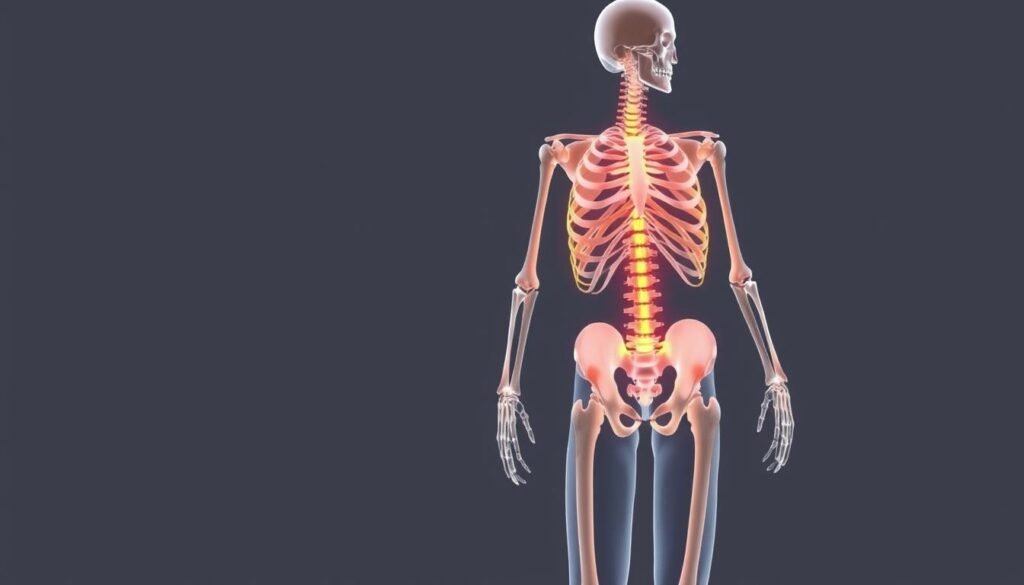About 66% of small cell lung cancer patients find out they have it at stage 4. This shows how advanced lung cancer often is when it affects the bones. This greatly influences the life expectancy of stage 4 lung cancer that has spread to bones. It’s vital for patients and their families to understand this as they face this tough time together.
Stage 4 lung cancer is the disease at its most severe. The cancer cells travel from the lungs to distant parts of the body, like the bones. The lung cancer prognosis at this stage highlights the need for early detection and proper treatment. These can really impact survival rates and life quality. Even though the situation seems tough, new treatments can offer hope and potentially extend life.
It’s critical to know that bone metastasis survival rates are usually low. For stage 4 non-small cell lung cancer (NSCLC), the 5-year survival rate is only about 9%. However, each person’s journey is different. Many factors such as health, age, and race can affect outcomes. Thanks to ongoing research, treatments are always improving. They offer new ways to manage and treat advanced lung cancer. To learn more about this topic, check life expectancy and survival rates for metastatic lung and understanding stage 4 lung cancer.
Key Takeaways
- Stage 4 lung cancer signifies advanced disease with potential spread to bones.
- About 60-70% of NSCLC patients are diagnosed in stage 4.
- The 5-year survival rate for stage 4 NSCLC is approximately 9%.
- New treatments aim to improve overall survival and quality of life.
- Bone metastasis significantly impacts prognosis and treatment decisions.
What is Stage 4 Lung Cancer?
Stage 4 lung cancer is the most serious form. It means the cancer has spread far from the lungs. This includes places like the bones, liver, and brain. These changes lead to many health challenges. Figuring out how to treat stage 4 lung cancer is tough. The chances of getting better are not very high.
Only about 5% of people with stage 4 lung cancer live for five years or more. For certain types of lung cancer, the survival rates are even lower. On average, people may live from 6.3 to 11.4 months after finding out they have it. This shows how severe the disease is at this stage.
Many things can affect someone’s chance of living longer. Overall health and how well treatment works are important. For example, smokers who stop smoking before starting chemotherapy can live up to six months longer. Other health issues can also change a person’s survival rate. This includes problems like heart failure and stroke.
When we talk about stage 4 lung cancer, we often mention five-year survival rates. This helps us understand how serious the condition is. Both doctors and patients need to know these details to manage the disease.
| Stage of Lung Cancer | Five-Year Survival Rate (%) | Average Survival Time (Months) |
|---|---|---|
| Stage 1 | 65 | Not applicable |
| Stage 2 | 40 | Not applicable |
| Stage 3 | 15 | Not applicable |
| Stage 4 | 5 | 6.3 – 11.4 |
For more info on how bone metastasis affects lung cancer patients, check out this study.
Understanding Bone Metastasis in Lung Cancer
Bone metastasis occurs when lung cancer cells spread to the bones. This usually happens through the bloodstream or lymphatic system. About 30-40% of people with advanced lung cancer will see their cancer spread to bones. Specifically, 20-30% of those with non-small cell lung cancer (NSCLC) find bone metastases at diagnosis. This number jumps to 35-60% as the cancer progresses.
Bone metastases come in different types, such as osteolytic, sclerotic, and mixed. Each type impacts patients differently, presenting various challenges. For example, those with skeletal-related events (SREs) may have a worse outlook. They also tend to suffer from more severe pain. Managing this pain is crucial, as it’s a common issue for those with bone metastases.
Having bone metastases often means dealing with a lot of health problems. It leads to a lower quality of life and a higher chance of dying sooner. These patients typically don’t do as well with systemic therapies as others do. A study revealed that the two-year survival rate for lung cancer patients with bone metastasis was only 11.3%.
Understanding bone metastasis helps us see its impact on stage 4 lung cancer spread to bones life expectancy. Those with a single bone tumor usually live longer, highlighting the need for early detection and treatment.
Stage 4 Lung Cancer Spread to Bones Life Expectancy
Understanding life expectancy with bone metastasis from lung cancer means looking at many critical factors. These include the type of tumor, patient’s gender, overall health, and how well the person can carry out daily activities. The choice of treatments, the number of metastases, and how well treatments work also play a big part.
Overview of Life Expectancy Factors
The outlook isn’t the same for everyone. For instance, men generally have a less favorable advanced lung cancer prognosis than women. Scores determining how well a person can perform daily activities, especially those using the Eastern Cooperative Oncology Group (ECOG) standards, are major factors. Patients with the best score (zero) can have a 45.9% chance of living five more years. Those with a score of two only have a 5.8% chance.
A study found that the average survival time after finding bone metastasis is about 148 days. People who don’t get treatment usually live around seven months. This highlights how important treatment is for living longer.
Statistical Survival Rates
Statistics give a clear idea of what to expect. The one-year survival rate for those with lung cancer and bone metastasis is very low at about 10%. This is quite different from breast cancer, with a one-year survival rate of about 51%. Prostate cancer patients, on the other hand, have a six-year survival rate of only 6% after metastasis.
For those with stage 4 non-small cell lung cancer, the numbers are troubling. Only 9% survive five years. The survival rates change with different types of lung cancer. For example, lung adenocarcinoma has a 20.6% survival rate, while squamous cell carcinoma’s is 17.6%. Patients under 50 have a 14.2% chance of living five more years. Those over 65 have only a 5.6% chance.
Just 12.4% of lung cancer patients get bone metastasis within five years. But if they do, their chance of surviving five years is only 1%. This shows how crucial good treatment and care are.
For more detailed info on these factors and findings, check out the study on lung cancer and bone metastasis.

Common Sites for Lung Cancer Bone Metastasis
Lung cancer often spreads to different parts of the body. Some bones are more likely to be affected. Knowing these spots is crucial for proper diagnosis and treatment. The main areas usually hit include:
- Spine
- Ribs
- ilium
- Sacrum
- Femur
These spots have a lot of red marrow, which makes them easy targets. Around 64.7% of small-cell lung cancer patients find their bone metastases here, mainly in the spine. Studies also show that about 74.5% of these patients have multiple bone sites impacted.
Distribution of Metastasis
Bone metastasis is quite common in lung cancer. This fact shows how hard the disease is to manage. Knowing how and where it spreads is key to treating it effectively. The survival rate changes based on the patient’s age and how many bones are affected.
Symptoms Involving Affected Bones
When lung cancer spreads to the bone, it can cause a lot of pain. Patients often report:
- Dull aches in the affected bones, which get worse over time
- Pain when moving or doing activities, especially in the infected bones
- Tingling or weakness from the spinal cord being involved
Spotting these early signs is important for choosing the right treatment. Later on, broken bones and issues with the spinal cord are big worries. Treatments like pain meds and maybe radiotherapy help ease the pain and care for the bones. For more information on where lung cancer usually spreads, check this out.

Symptoms and Complications of Bone Metastasis
Bone metastasis greatly affects those with lung cancer, showing several symptoms and complications. Knowing about these can lead to better management of pain. And, it can help improve life quality.
Initial Symptoms and Pain Management
Most patients, about 80%, first notice significant pain. Managing this pain is key to avoiding a dip in life quality. There are different treatments to help with pain:
- Nonsteroidal anti-inflammatory drugs (NSAIDs)
- Acetaminophen
- Opioids for severe pain
- Adjuvant therapies like steroids and bisphosphonates
Making a pain management plan tailored to the individual can greatly enhance their journey through this tough period.
Severe Complications Related to Bone Mets
Bone metastases might cause serious issues that need quick medical help to stop more harm. These issues include:
- Pathological Fractures: They can happen suddenly, causing lots of pain, deformity, and sometimes an inability to move.
- Spinal Cord Compression: A critical condition leading to nerve problems, which might get worse without immediate treatment.
- Hypercalcemia: High calcium levels bringing on symptoms like too much thirst, weakness, and confusion. This needs fast treatment.
Quickly dealing with these severe bone mets complications eases symptoms and helps maintain independence and functionality for the affected.
| Complication | Symptoms | Management Strategies |
|---|---|---|
| Pathological Fractures | Pain, deformity, immobility | Rest, pain relief, stabilization |
| Spinal Cord Compression | Nerve damage, weakness, paralysis | Surgery, corticosteroids, radiation |
| Hypercalcemia | Extreme thirst, fatigue, disorientation | Hydration, bisphosphonates, calcitonin |

Diagnostic Methods for Bone Metastasis
Finding bone metastasis, especially in lung cancer patients, involves many diagnostic steps. Each step is key to understanding the disease’s spread and planning treatment.
Imaging Studies Utilized
Doctors use several imaging tests to find bone metastasis. These include:
- X-rays – Usually the first step, helpful in spotting lesions but might miss tiny ones.
- CT scans – Offer clear images of bones, showing potential lesions better.
- MRIs – Best for looking at soft tissues and detecting changes in the marrow.
- PET scans – Use radioactivity to find active disease areas, adding more details to other tests.
Each imaging type has its own pros and cons. Doctors choose which one based on what the patient needs.
Blood Tests for Diagnostic Confirmation
Along with images, blood tests help confirm if there’s bone metastasis and check overall health. Important tests include:
| Test | Purpose |
|---|---|
| CBC (Complete Blood Count) | Shows general health status and finds anemia or infection, common issues with metastasis. |
| CMP (Comprehensive Metabolic Panel) | Checks body’s chemical balance, pinpointing problems like too much calcium from bone metastasis. |
Combining blood tests with images improves diagnosis accuracy. This helps in starting treatment sooner for patients.
Learning about diagnostic methods for bone metastasis is important. Knowing how imaging and tests work together helps in treating lung cancer better.
Treatment Options for Bone Metastasis in Lung Cancer
Treating bone metastasis from lung cancer focuses on easing symptoms and bettering life quality. A mix of treatments helps with local and entire body issues. This ensures both comfort and disease control.
Palliative Care Approaches
Palliative care is crucial for managing symptoms of bone metastasis. It aims to improve the patient’s life by meeting physical, emotional, and spiritual needs. Important parts of palliative care are:
- Pain management: Getting the right pain relief is key. This often involves drugs like analgesics and opioids.
- Supportive services: Counseling, nutritional advice, and rehab greatly aid patient care.
- Symptom relief: Some treatments help with bone-related symptoms, like fractures or nerve issues.
Systemic and Localized Treatments
Systemic treatments aim at the whole body. They work to shrink tumors and lessen metastatic disease impacts. Options include:
- Chemotherapy: This can manage metastatic lung cancer, shrinking tumors and easing symptoms.
- Targeted therapies: Drugs like epidermal growth factor receptor inhibitors are tailored to certain genetic changes. They can make treatments more effective.
Localized treatments directly tackle bone complications. Strategies include:
- Radiation therapy: Focused on specific bone sites, it can greatly ease pain and lower fracture risks.
- Surgery: For serious complications, surgery might be needed to stabilize bones or reduce spinal cord pressure.
- Bisphosphonates and denosumab: These drugs work on bone density, decreasing the chance of bone-related issues.
Prognostic Factors Influencing Bone Metastasis Outcomes
Knowing the prognostic factors in lung cancer helps predict outcomes and tailor treatment. The primary tumor type greatly influences prognosis. Adenocarcinoma is most common, making up more than half of lung cancer cases.
Patients with adenocarcinoma tend to live longer than those with other types. This is because they respond better to treatments like chemotherapy and radiation. Those with bone metastasis from adenocarcinoma especially see survival benefits.
Impact of Primary Tumor Type
The impact of tumor type on prognosis is critical. But, so is the role of performance status. The Eastern Cooperative Oncology Group (ECOG) scale measures patient functionality. High ECOG scores point to worse health and outcomes.
Patients with a good performance status typically see better results from treatment. They also report a higher quality of life. This highlights how vital overall health is in stage 4 lung cancer with bone metastasis management.
Role of Performance Status in Prognosis
The primary tumor type and performance status are key in lung cancer with bone metastasis. They help healthcare providers make better decisions for treatment. This leads to more effective care and a better experience for patients.
Continuously monitoring and personalizing treatment plans can improve survival rates. It can also raise the quality of life for those battling this tough disease.